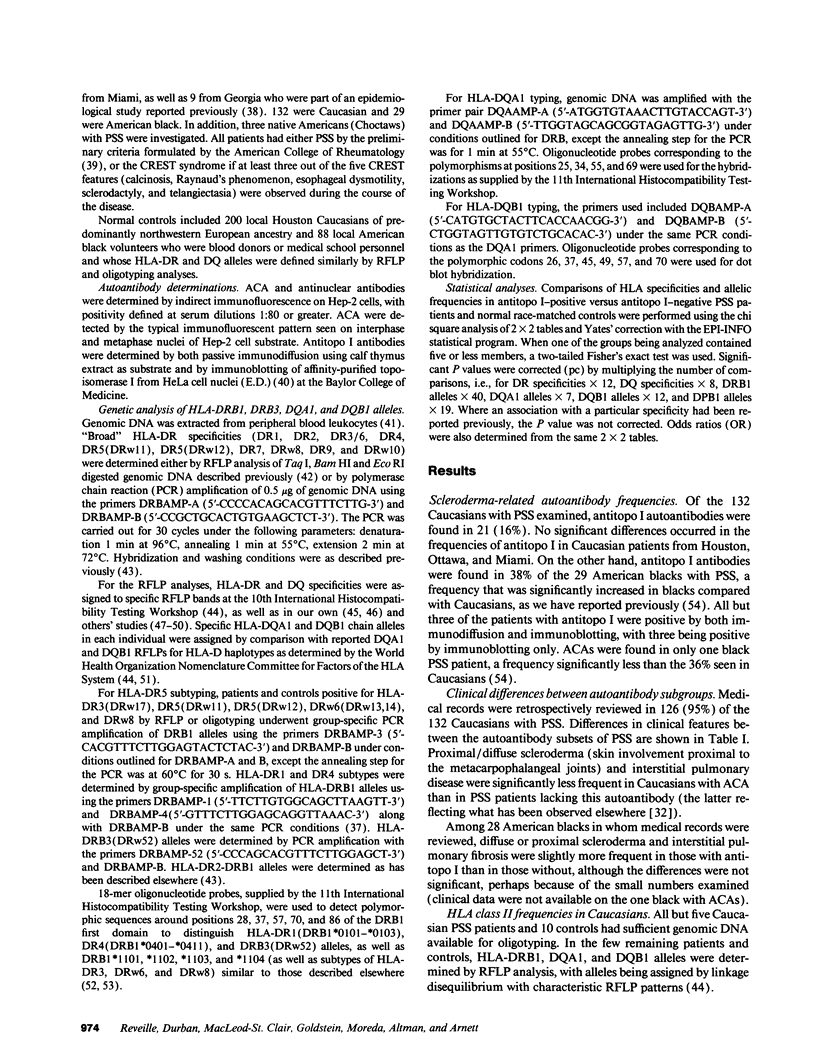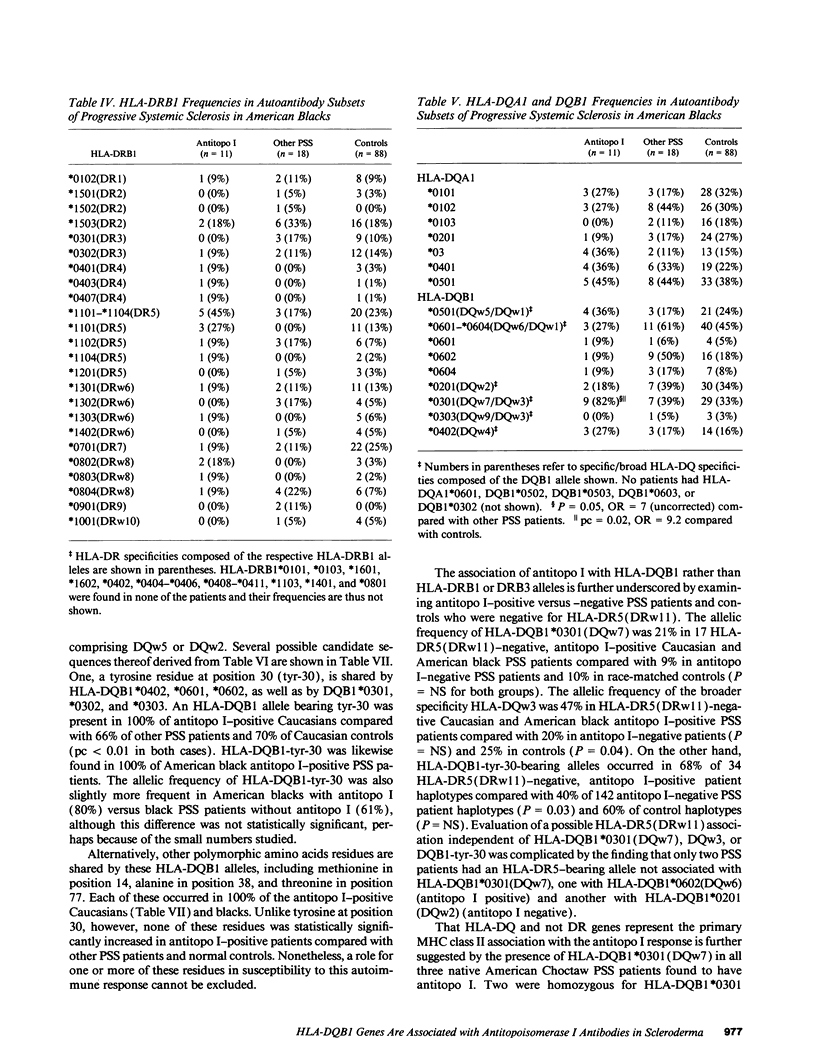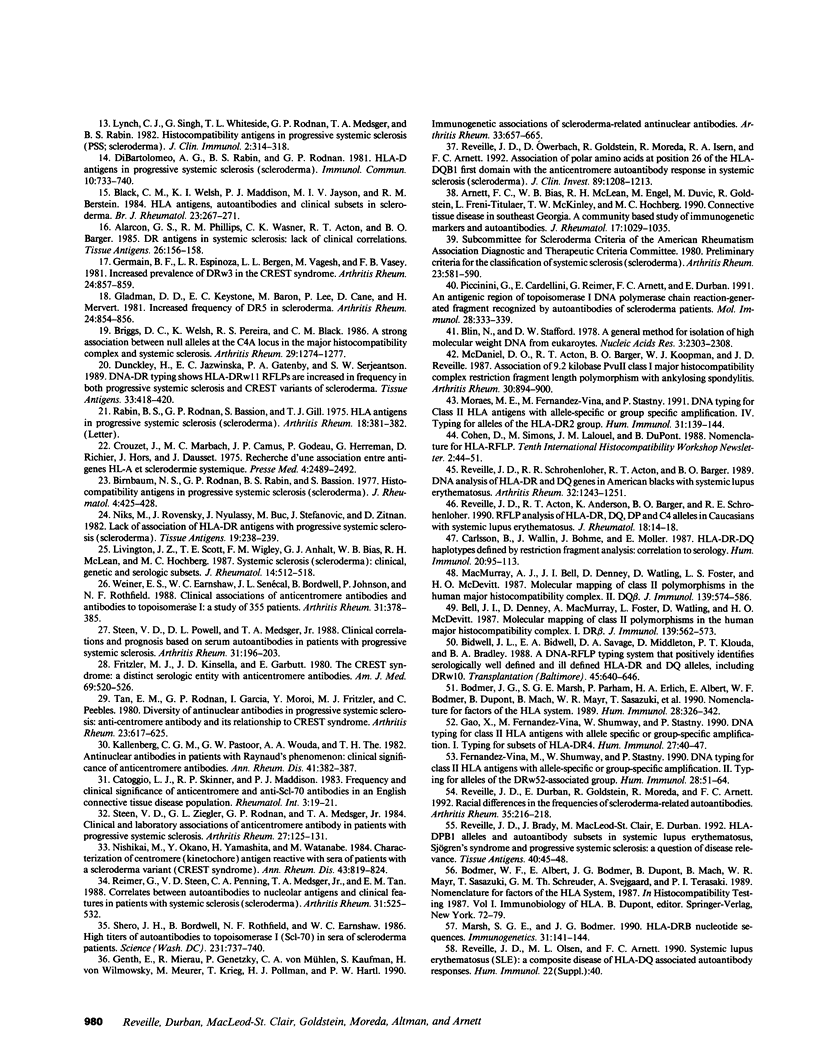Abstract
Previous studies in Caucasians with progressive systemic sclerosis (PSS) have suggested associations of antitopoisomerase I (antitopo I) autoantibodies with either serologically defined HLA-DR2 or DR5. To better define class II HLA associations with the antitopo I response, 161 PSS patients (132 Caucasians and 29 American blacks) were studied for antitopo I autoantibodies by immunodiffusion and immunoblotting, and their HLA-DRB1, DRB3, DQA1, and DQB1 alleles were determined by restriction fragment length polymorphic analysis and DNA oligotyping. Among Caucasians with antitopo I, HLA-DR5(DRB1*1101-*1104), DRB3*0202 and DQw3 (DQw7,8,9) were significantly increased in frequency. In American blacks, however, only HLA-DQB1*0301(DQw7) was significantly increased. The presence of HLA-DQB1*0301(DQw7) and other HLA-DQB1 alleles bearing the uncharged polar amino acid residue tyrosine at position 30 of the outermost domain was found in all antitopo I-positive Caucasian PSS patients compared with 66% of antitopo I-negative PSS patients (pc = 0.007) and 70% of normal controls (pc = 0.008), as well as all antitopo I-positive black patients. The association with HLA-DQB1 was independent of HLA-DR5(DRB1*1101-*1104) or any other HLA-DRB1, DRB3, or DQA1 alleles. Alternative or additional candidate epitopes for this autoimmune response include alanine at position 38 and threonine at position 77 of these same DQB1 alleles. These data suggest that genetic predisposition to the antitopo I response in PSS is associated most closely with the HLA-DQB1 locus.
Full text
PDF







Selected References
These references are in PubMed. This may not be the complete list of references from this article.
- Alarcón G. S., Phillips R. M., Wasner C. K., Acton R. T., Barger B. O. DR antigens in systemic sclerosis: lack of clinical correlations. Tissue Antigens. 1985 Aug;26(2):156–158. doi: 10.1111/j.1399-0039.1985.tb00950.x. [DOI] [PubMed] [Google Scholar]
- Arnett F. C., Bias W. B., McLean R. H., Engel M., Duvic M., Goldstein R., Freni-Titulaer L., McKinley T. W., Hochberg M. C. Connective tissue disease in southeast Georgia. A community based study of immunogenetic markers and autoantibodies. J Rheumatol. 1990 Aug;17(8):1029–1035. [PubMed] [Google Scholar]
- Bell J. I., Denney D., Jr, MacMurray A., Foster L., Watling D., McDevitt H. O. Molecular mapping of class II polymorphisms in the human major histocompatibility complex. I. DR beta. J Immunol. 1987 Jul 15;139(2):562–573. [PubMed] [Google Scholar]
- Bidwell J. L., Bidwell E. A., Savage D. A., Middleton D., Klouda P. T., Bradley B. A. A DNA-RFLP typing system that positively identifies serologically well-defined and ill-defined HLA-DR and DQ alleles, including DRw10. Transplantation. 1988 Mar;45(3):640–646. doi: 10.1097/00007890-198803000-00027. [DOI] [PubMed] [Google Scholar]
- Birnbaum N. S., Rodnan G. P., Rabin B. S., Bassion S. Histocompatibility antigens in progressive systemic sclerosis (scleroderma). J Rheumatol. 1977 Winter;4(4):425–428. [PubMed] [Google Scholar]
- Black C. M., Welsh K. I., Maddison P. J., Jayson M. I., Bernstein R. M. HLA antigens, autoantibodies and clinical subsets in scleroderma. Br J Rheumatol. 1984 Nov;23(4):267–271. doi: 10.1093/rheumatology/23.4.267. [DOI] [PubMed] [Google Scholar]
- Blin N., Stafford D. W. A general method for isolation of high molecular weight DNA from eukaryotes. Nucleic Acids Res. 1976 Sep;3(9):2303–2308. doi: 10.1093/nar/3.9.2303. [DOI] [PMC free article] [PubMed] [Google Scholar]
- Bodmer J. G., Marsh S. G., Parham P., Erlich H. A., Albert E., Bodmer W. F., Dupont B., Mach B., Mayr W. R., Sasazuki T. Nomenclature for factors of the HLA system, 1989. Hum Immunol. 1990 Jul;28(3):326–342. doi: 10.1016/0198-8859(90)90060-3. [DOI] [PubMed] [Google Scholar]
- Briggs D. C., Welsh K., Pereira R. S., Black C. M. A strong association between null alleles at the C4A locus in the major histocompatibility complex and systemic sclerosis. Arthritis Rheum. 1986 Oct;29(10):1274–1277. doi: 10.1002/art.1780291014. [DOI] [PubMed] [Google Scholar]
- Buckman K. J., Moore S. K., Ebbin A. J., Cox M. B., Dubois E. L. Familial systemic lupus erythematosus. Arch Intern Med. 1978 Nov;138(11):1674–1676. [PubMed] [Google Scholar]
- Carlsson B., Wallin J., Böhme J., Möller E. HLA-DR-DQ haplotypes defined by restriction fragment analysis. Correlation to serology. Hum Immunol. 1987 Oct;20(2):95–113. doi: 10.1016/0198-8859(87)90025-5. [DOI] [PubMed] [Google Scholar]
- Catoggio L. J., Skinner R. P., Maddison P. J. Frequency and clinical significance of anticentromere and anti Scl-70 antibodies in an English connective tissue disease population. Rheumatol Int. 1983;3(1):19–21. doi: 10.1007/BF00541227. [DOI] [PubMed] [Google Scholar]
- Clements P. J., Opelz G., Terasaki P. I., Mickey M. R., Furst D. Association of HLA antigen a9 with progressive systemic sclerosis (scleroderma). Tissue Antigens. 1978 Apr;11(4):357–361. doi: 10.1111/j.1399-0039.1978.tb01268.x. [DOI] [PubMed] [Google Scholar]
- Crouzet J., Marbach M. C., Camus J. P., Godeau P., Herreman G., Richier D., Hors J., Dausset J. Recherche d'une association entre antigènes HL-A et sclérodermie systémique. Nouv Presse Med. 1975 Oct 18;4(35):2489–2492. [PubMed] [Google Scholar]
- DiBartolomeo A. G., Rabin B. S., Rodnan G. P. HLA-D antigens in progressive systemic sclerosis (scleroderma). Immunol Commun. 1981;10(8):733–740. doi: 10.3109/08820138109051959. [DOI] [PubMed] [Google Scholar]
- Dunckley H., Jazwinska E. C., Gatenby P. A., Serjeantson S. W. DNA-DR typing shows HLA-DRw11 RFLPs are increased in frequency in both progressive systemic sclerosis and CREST variants of scleroderma. Tissue Antigens. 1989 Mar;33(3):418–420. doi: 10.1111/j.1399-0039.1989.tb01686.x. [DOI] [PubMed] [Google Scholar]
- Ercilla M. G., Arriaga F., Gratacós M. R., Coll J., Lecha V., Vives J., Castillo R. HLA antigens and scleroderma. Arch Dermatol Res. 1981;271(4):381–385. doi: 10.1007/BF00406682. [DOI] [PubMed] [Google Scholar]
- Fernandez-Vina M., Shumway W., Stastny P. DNA typing for class II HLA antigens with allele-specific or group-specific amplification. II. Typing for alleles of the DRw52-associated group. Hum Immunol. 1990 May;28(1):51–64. doi: 10.1016/0198-8859(90)90102-u. [DOI] [PubMed] [Google Scholar]
- Finch W. R., Rodnan G. P., Buckingham R. B., Prince R. K., Winkelstein A. Bleomycin-induced scleroderma. J Rheumatol. 1980 Sep-Oct;7(5):651–659. [PubMed] [Google Scholar]
- Flores R. H., Stevens M. B., Arnett F. C. Familial occurrence of progressive systemic sclerosis and systemic lupus erythematosus. J Rheumatol. 1984 Jun;11(3):321–323. [PubMed] [Google Scholar]
- Fritzler M. J., Kinsella T. D. The CREST syndrome: a distinct serologic entity with anticentromere antibodies. Am J Med. 1980 Oct;69(4):520–526. doi: 10.1016/0002-9343(80)90462-3. [DOI] [PubMed] [Google Scholar]
- Gao X. J., Fernandez-Vina M., Shumway W., Stastny P. DNA typing for class II HLA antigens with allele-specific or group-specific amplification. I. Typing for subsets of HLA-DR4. Hum Immunol. 1990 Jan;27(1):40–50. doi: 10.1016/0198-8859(90)90094-6. [DOI] [PubMed] [Google Scholar]
- Genth E., Mierau R., Genetzky P., von Mühlen C. A., Kaufmann S., von Wilmowsky H., Meurer M., Krieg T., Pollmann H. J., Hartl P. W. Immunogenetic associations of scleroderma-related antinuclear antibodies. Arthritis Rheum. 1990 May;33(5):657–665. doi: 10.1002/art.1780330508. [DOI] [PubMed] [Google Scholar]
- Germain B. F., Espinoza L. R., Bergen L. L., Vagesh M., Vasey F. B. Increased prevalence of DRw3 in the CREST syndrome. Arthritis Rheum. 1981 Jun;24(6):857–859. doi: 10.1002/art.1780240615. [DOI] [PubMed] [Google Scholar]
- Gladman D. D., Keystone E. C., Baron M., Lee P., Cane D., Mervert H. Increased frequency of HLA-DR5 in scleroderma. Arthritis Rheum. 1981 Jun;24(6):854–856. doi: 10.1002/art.1780240614. [DOI] [PubMed] [Google Scholar]
- Hughes P., Gelsthorpe K., Doughty R. W., Rowell N. R., Rosenthal F. D., Sneddon I. B. The association of HLA-B8 with visceral disease in systemic sclerosis. Clin Exp Immunol. 1978 Mar;31(3):351–356. [PMC free article] [PubMed] [Google Scholar]
- Kallenberg C. G., Pastoor G. W., Wouda A. A., The T. H. Antinuclear antibodies in patients with Raynaud's phenomenon: clinical significance of anticentromere antibodies. Ann Rheum Dis. 1982 Aug;41(4):382–387. doi: 10.1136/ard.41.4.382. [DOI] [PMC free article] [PubMed] [Google Scholar]
- Kallenberg C. G., Van der Voort-Beelen J. M., D'Amaro J., The T. H. Increased frequency of B8/DR3 in scleroderma and association of the haplotype with impaired cellular immune response. Clin Exp Immunol. 1981 Mar;43(3):478–485. [PMC free article] [PubMed] [Google Scholar]
- Lilis R., Anderson H., Nicholson W. J., Daum S., Fischbein A. S., Selikoff I. J. Prevalence of disease among vinyl chloride and polyvinyl chloride workers. Ann N Y Acad Sci. 1975 Jan 31;246:22–41. doi: 10.1111/j.1749-6632.1975.tb51078.x. [DOI] [PubMed] [Google Scholar]
- Livingston J. Z., Scott T. E., Wigley F. M., Anhalt G. J., Bias W. B., McLean R. H., Hochberg M. C. Systemic sclerosis (scleroderma): clinical, genetic, and serologic subsets. J Rheumatol. 1987 Jun;14(3):512–518. [PubMed] [Google Scholar]
- Lynch C. J., Singh G., Whiteside T. L., Rodnan G. P., Medsger T. A., Jr, Rabin B. S. Histocompatibility antigens in progressive systemic sclerosis (PSS; scleroderma). J Clin Immunol. 1982 Oct;2(4):314–318. doi: 10.1007/BF00915073. [DOI] [PubMed] [Google Scholar]
- MacMurray A. J., Bell J. I., Denney D., Jr, Watling D., Foster L. S., McDevitt H. O. Molecular mapping class II polymorphisms in the human major histocompatibility complex. II. DQ beta. J Immunol. 1987 Jul 15;139(2):574–586. [PubMed] [Google Scholar]
- Marsh S. G., Bodmer J. G. HLA-DRB nucleotide sequences, 1990. Immunogenetics. 1990;31(3):141–144. doi: 10.1007/BF00211548. [DOI] [PubMed] [Google Scholar]
- Mateo I. M., Izquierdo M., Fernandez-Dapica M. P., Navas J., Cabello A., Gomez-Reino J. J. Toxic epidemic syndrome: musculoskeletal manifestations. J Rheumatol. 1984 Jun;11(3):333–338. [PubMed] [Google Scholar]
- McDaniel D. O., Acton R. T., Barger B. O., Koopman W. J., Reveille J. D. Association of a 9.2-kilobase Pvu II class I major histocompatibility complex restriction fragment length polymorphism with ankylosing spondylitis. Arthritis Rheum. 1987 Aug;30(8):894–900. doi: 10.1002/art.1780300808. [DOI] [PubMed] [Google Scholar]
- Medsger T. A., Jr, Masi A. T. Epidemiology of systemic sclerosis (scleroderma). Ann Intern Med. 1971 May;74(5):714–721. doi: 10.7326/0003-4819-74-5-714. [DOI] [PubMed] [Google Scholar]
- Mollenhauer E., Schmidt R., Heinrichs M., Rittner C. Scleroderma: possible significance of silent alleles at the C4B locus. Arthritis Rheum. 1984 Jun;27(6):711–712. doi: 10.1002/art.1780270619. [DOI] [PubMed] [Google Scholar]
- Moraes M. E., Fernandez-Viña M., Stastny P. DNA typing for class II HLA antigens with allele-specific or group-specific amplification. IV. Typing for alleles of the HLA-DR2 group. Hum Immunol. 1991 Jun;31(2):139–144. doi: 10.1016/0198-8859(91)90017-4. [DOI] [PubMed] [Google Scholar]
- Niks M., Rovenský J., Nyulassy S., Buc M., Stefanovic J., Zitnan D. Lack of association of HLA-DR antigens with progressive systemic sclerosis (scleroderma). Tissue Antigens. 1982 Mar;19(3):238–239. doi: 10.1111/j.1399-0039.1982.tb01446.x. [DOI] [PubMed] [Google Scholar]
- Nishikai M., Okano Y., Yamashita H., Watanabe M. Characterisation of centromere (kinetochore) antigen reactive with sera of patients with a scleroderma variant (CREST syndrome). Ann Rheum Dis. 1984 Dec;43(6):819–824. doi: 10.1136/ard.43.6.819. [DOI] [PMC free article] [PubMed] [Google Scholar]
- Palestine R. F., Millns J. L., Spigel G. T., Schroeter A. L. Skin manifestations of pentazocine abuse. J Am Acad Dermatol. 1980 Jan;2(1):47–55. doi: 10.1016/s0190-9622(80)80292-1. [DOI] [PubMed] [Google Scholar]
- Rabin B. S., Rodnan G. P., Bassion S., Gill T. J., 3rd Letter: HL-A antigens in progressive systemic sclerosis (scleroderma). Arthritis Rheum. 1975 Jul-Aug;18(4):381–382. doi: 10.1002/art.1780180418. [DOI] [PubMed] [Google Scholar]
- Reimer G., Steen V. D., Penning C. A., Medsger T. A., Jr, Tan E. M. Correlates between autoantibodies to nucleolar antigens and clinical features in patients with systemic sclerosis (scleroderma). Arthritis Rheum. 1988 Apr;31(4):525–532. doi: 10.1002/art.1780310409. [DOI] [PubMed] [Google Scholar]
- Reveille J. D., Anderson K. L., Schrohenloher R. E., Acton R. T., Barger B. O. Restriction fragment length polymorphism analysis of HLA-DR, DQ, DP and C4 alleles in Caucasians with systemic lupus erythematosus. J Rheumatol. 1991 Jan;18(1):14–18. [PubMed] [Google Scholar]
- Reveille J. D., Durban E., Goldstein R., Moreda R., Arnett F. C. Racial differences in the frequencies of scleroderma-related autoantibodies. Arthritis Rheum. 1992 Feb;35(2):216–218. doi: 10.1002/art.1780350215. [DOI] [PubMed] [Google Scholar]
- Reveille J. D., Owerbach D., Goldstein R., Moreda R., Isern R. A., Arnett F. C. Association of polar amino acids at position 26 of the HLA-DQB1 first domain with the anticentromere autoantibody response in systemic sclerosis (scleroderma). J Clin Invest. 1992 Apr;89(4):1208–1213. doi: 10.1172/JCI115704. [DOI] [PMC free article] [PubMed] [Google Scholar]
- Reveille J. D., Schrohenloher R. E., Acton R. T., Barger B. O. DNA analysis of HLA-DR and DQ genes in American blacks with systemic lupus erythematosus. Arthritis Rheum. 1989 Oct;32(10):1243–1251. doi: 10.1002/anr.1780321009. [DOI] [PubMed] [Google Scholar]
- Shero J. H., Bordwell B., Rothfield N. F., Earnshaw W. C. High titers of autoantibodies to topoisomerase I (Scl-70) in sera from scleroderma patients. Science. 1986 Feb 14;231(4739):737–740. doi: 10.1126/science.3003910. [DOI] [PubMed] [Google Scholar]
- Steen V. D., Powell D. L., Medsger T. A., Jr Clinical correlations and prognosis based on serum autoantibodies in patients with systemic sclerosis. Arthritis Rheum. 1988 Feb;31(2):196–203. doi: 10.1002/art.1780310207. [DOI] [PubMed] [Google Scholar]
- Steen V. D., Ziegler G. L., Rodnan G. P., Medsger T. A., Jr Clinical and laboratory associations of anticentromere antibody in patients with progressive systemic sclerosis. Arthritis Rheum. 1984 Feb;27(2):125–131. doi: 10.1002/art.1780270202. [DOI] [PubMed] [Google Scholar]
- Tan E. M., Rodnan G. P., Garcia I., Moroi Y., Fritzler M. J., Peebles C. Diversity of antinuclear antibodies in progressive systemic sclerosis. Anti-centromere antibody and its relationship to CREST syndrome. Arthritis Rheum. 1980 Jun;23(6):617–625. doi: 10.1002/art.1780230602. [DOI] [PubMed] [Google Scholar]
- Weiner E. S., Earnshaw W. C., Senécal J. L., Bordwell B., Johnson P., Rothfield N. F. Clinical associations of anticentromere antibodies and antibodies to topoisomerase I. A study of 355 patients. Arthritis Rheum. 1988 Mar;31(3):378–385. doi: 10.1002/art.1780310309. [DOI] [PubMed] [Google Scholar]


